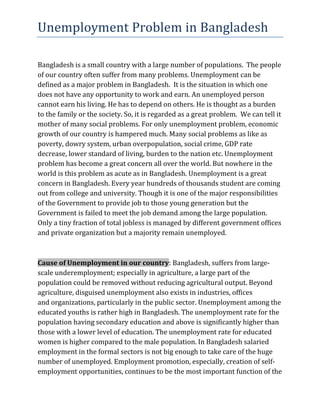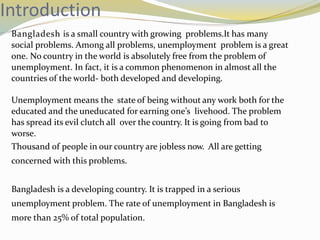The unemployment problem in Bangladesh stems from limited job opportunities and rapid population growth. This issue has led to a high rate of job seekers relative to job availability, impacting the country’s economy and social fabric.
Unemployment rates vary across urban and rural areas, with youth unemployment being particularly concerning. Factors such as lack of proper skills training, underemployment, and mismatch between education and job requirements contribute to the persistent problem. Addressing this issue requires a multi-faceted approach that includes creating more job opportunities, investing in education and skill development programs, and promoting entrepreneurship.
By tackling these challenges, Bangladesh can work towards reducing unemployment rates and fostering sustainable economic growth.

Credit: www.youtube.com
Causes Of Unemployment
The job market in Bangladesh faces several challenges leading to high rates of unemployment in the country.
Lack Of Skill Development
Limited access to skill development programs results in many individuals lacking the necessary abilities for available job opportunities.
Overpopulation
Rapid population growth surpasses job creation rates, leading to a surplus of job seekers compared to available positions.
Technological Advancement
Automation and technological advancements have replaced traditional labor, reducing overall job availability for the workforce.

Credit: www.slideshare.net
Types Of Unemployment
Unemployment in Bangladesh is a significant issue that impacts the social and economic landscape. Understanding the various types of unemployment is crucial in addressing this problem effectively.
Structural Unemployment
Occurs due to shifts in the economy and lack of skills matching market demands. Resources insufficiently allocated for job seekers.
Frictional Unemployment
Temporary unemployment during job transitions or searching. Short-term and results from natural labor market movements.
Cyclical Unemployment
Linked to economic cycles like recession and recovery phases. Caused by fluctuations in business activity.
Effects Of Unemployment
Unemployment has far-reaching effects on both the social and economic fabric of a country. The repercussions of unemployment are profound and impact the well-being of individuals and communities at large. Let’s delve into the repercussions of unemployment in Bangladesh and examine how it affects the society and economy.
Social Consequences
Unemployment can lead to social unrest, as individuals are deprived of the opportunity to contribute meaningfully to society. This deprivation can result in heightened levels of stress and anxiety among the unemployed, leading to a decline in overall mental well-being. Additionally, unemployment often leads to an increase in social stratification and a sense of marginalization within the community. Families of the unemployed are particularly impacted, facing heightened levels of financial strain and social stigma.
Economic Repercussions
Unemployment bears a heavy economic burden, contributing to the stagnation of economic growth and the aggravation of poverty. It diminishes the tax base as there are fewer individuals contributing to government revenues, and increases the demand for social welfare programs. Furthermore, unemployment results in a loss of productivity and innovation, leading to a decline in the country’s overall economic potential.

Credit: pt.slideshare.net
Government Initiatives
Addressing the unemployment issue in Bangladesh, the government has introduced various initiatives to provide job opportunities and vocational training to the youth. These programs aim to reduce the unemployment rate and boost economic growth in the country. By focusing on skill development and creating job prospects, the government is working towards improving the overall employment scenario in Bangladesh.
Unemployment is a major concern in Bangladesh, but the government has implemented various initiatives to address this issue. These initiatives focus on creating jobs, skill development, and promoting youth entrepreneurship. Let’s take a closer look at each of these initiatives.Job Creation Programs
The government has introduced several programs to create more employment opportunities in Bangladesh. These programs prioritize sectors with high growth potential such as agriculture, manufacturing, and services. They aim to stimulate economic growth and reduce the unemployment rate. One prominent initiative is the “100 Days Employment Generation Program.” This program aims to provide temporary employment to unemployed individuals in rural areas. Participants engage in various development projects like infrastructure construction, land reclamation, and tree plantation. It not only addresses unemployment but also enhances the country’s infrastructure. Another noteworthy program is the “Special Employment Scheme for Women.” This initiative recognizes the importance of empowering women in the workforce. It focuses on creating job opportunities specifically for women in both rural and urban areas. By ensuring equal participation, this program promotes gender equality and economic development.Skill Development Initiatives
To tackle unemployment effectively, the government has emphasized skill development initiatives. The goal is to equip the workforce with the necessary skills that align with the demands of the job market. These initiatives encompass vocational training, technical education, and entrepreneurship development. The Technical and Vocational Education and Training (TVET) program play a vital role in this regard. Through TVET, individuals can acquire industry-specific skills, enhancing their employability. The government has collaborated with various organizations and stakeholders to ensure quality training and certification. Moreover, initiatives like the “Skills for Employment Investment Program” (SEIP) provide training based on industry demand. This program focuses on upgrading the skills of young job seekers, ensuring they can meet market requirements. Such skill development initiatives not only reduce unemployment but also contribute to economic growth.Youth Entrepreneurship Schemes
Recognizing the potential and enthusiasm of the youth, the government has introduced youth entrepreneurship schemes. These initiatives aim to promote self-employment and encourage young individuals to become job creators. One such scheme is the “Youth Entrepreneurship Loan Program.” Through this program, aspiring entrepreneurs can access financial support to start their own ventures. The loan program offers low-interest rates and flexible repayment options, making it more accessible to young entrepreneurs. Additionally, the government has established business incubation centers across the country. These centers provide aspiring entrepreneurs with mentorship, training, and networking opportunities. They assist in refining business ideas and transforming them into successful ventures. These youth entrepreneurship schemes act as catalysts for economic growth by fostering innovation, creativity, and job creation. They encourage young individuals to utilize their skills and talents to become self-employed, reducing dependency on traditional job markets. In conclusion, the government of Bangladesh has implemented various initiatives to tackle the unemployment problem. These initiatives focus on job creation programs, skill development, and promoting youth entrepreneurship. By addressing the root causes of unemployment and providing necessary support, the government strives to foster economic growth and create a brighter future for the country.Challenges And Solutions
Unemployment is a critical issue in Bangladesh, and addressing it requires tackling several challenges. These challenges involve matching skills with job demands, population control measures, and adapting to technological changes. Let’s explore each of these challenges and the potential solutions they offer:
Matching Skills With Job Demands
In Bangladesh, one of the major obstacles in reducing unemployment is the mismatch between the skills possessed by job seekers and the requirements of available jobs. Many individuals lack the necessary qualifications, and they often struggle to find suitable employment opportunities.
To bridge this gap, the government and relevant stakeholders need to collaborate and implement measures that focus on enhancing skill development programs. By offering vocational training and education programs, individuals can acquire the skills demanded by the job market. Furthermore, partnerships with private organizations can help align training programs with industry needs, ensuring better employability for job seekers.
Population Control Measures
The rapid population growth in Bangladesh has put immense pressure on the job market, resulting in a high unemployment rate. It is crucial to implement effective population control measures to mitigate this challenge. Educating and creating awareness among people about family planning methods can significantly contribute to population control.
Additionally, offering incentives and benefits to families who choose to have fewer children can encourage responsible family planning. This approach not only helps alleviate the burden on the job market but also improves living standards for families, as they can allocate more resources to each child’s education and well-being.
Adapting To Technological Changes
The world is rapidly evolving technologically, and industries are constantly embracing automation and digitalization. However, this transition poses a risk of job displacement for individuals whose skills become obsolete.
To address this challenge, Bangladesh needs to prioritize specialized training and re-skilling programs that equip individuals with the necessary technological knowledge. Investing in research and development centers, promoting entrepreneurship, and fostering innovation can create a workforce that can adapt to emerging technologies and contribute to the country’s economic growth.
Conclusion:
Unemployment in Bangladesh requires multi-faceted solutions. By focusing on matching skills with job demands, implementing population control measures, and adapting to technological changes, the country can take significant strides in alleviating the unemployment problem. Through strategic planning and effective implementation, Bangladesh can create a more inclusive and prosperous job market for its citizens.
Role Of Education
The Role of Education is vital in addressing the unemployment problem in Bangladesh. Understanding the relevant curriculum and fostering industry-academic collaboration are key aspects to ensure that education plays a significant role in preparing individuals for the workforce.
Relevant Curriculum
A curriculum tailored to meet the demands of the evolving job market is essential. By incorporating technology-oriented and practical skills-based courses, educational institutions can equip students with the necessary competencies. Introducing entrepreneurship and innovation as part of the curriculum can also foster an entrepreneurial mindset among students.
Industry-academic Collaboration
Collaboration between industries and academic institutions is crucial for promoting hands-on training and providing real-world experiences to students. This collaboration can facilitate internship programs, industry visits, and workshops that align education with the needs of the job market. It also allows educators to stay updated on industry trends and adjust the curriculum accordingly.
Frequently Asked Questions Of Unemployment Problem In Bangladesh Composition
What Are The Causes Of Unemployment In Bangladesh?
Unemployment in Bangladesh can be attributed to factors such as population growth, insufficient job opportunities, lack of necessary skills, and economic instability. These factors contribute to the high unemployment rates in the country.
How Does Unemployment Affect The Economy Of Bangladesh?
Unemployment negatively impacts the economy of Bangladesh by reducing consumer spending, limiting economic growth, and increasing poverty rates. It also hampers the country’s ability to attract foreign investment and leads to a loss of productivity.
What Measures Can Be Taken To Address The Unemployment Problem In Bangladesh?
To address the unemployment problem in Bangladesh, the government and private sector can work together to create more job opportunities. This can be done through investments in sectors with high growth potential, promoting entrepreneurship, and improving the education system to meet the needs of the job market.
What Role Does Skill Development Play In Reducing Unemployment In Bangladesh?
Skill development programs and initiatives play a crucial role in reducing unemployment in Bangladesh. By equipping individuals with the necessary skills, they become more employable and can contribute effectively to the workforce. Additionally, vocational training programs can help bridge the gap between job requirements and the skills possessed by individuals.
Conclusion
The issue of unemployment in Bangladesh is a complex challenge that requires multi-faceted solutions. By addressing education, skill development, and fostering a favorable business environment, the country can work towards reducing unemployment rates and improving the standard of living for its citizens.
It’s crucial for policymakers to prioritize these efforts and work towards a brighter future for all.







